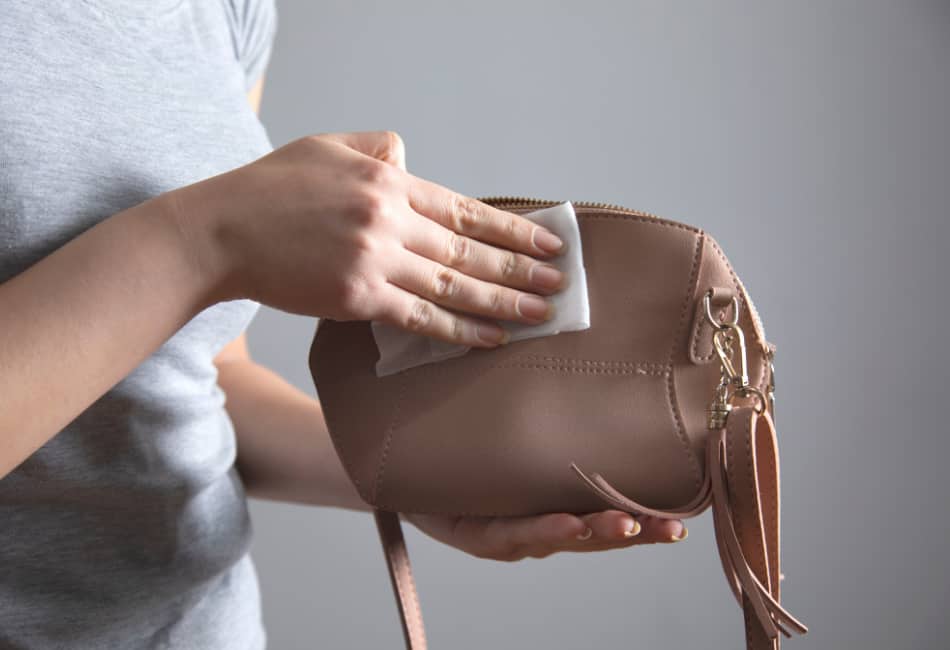There are a lot of myths and misconceptions about leather care. One of the most common is that you can’t use alcohol on leather. This isn’t true! In fact, alcohol can be an awful way to clean or treat your leather items and so in this article, I will discuss the downsides of using alcohol on leather, as well as some better alternatives.
What Do We Mean By Alcohol?
First, it is important to clarify what type of alcohol we are talking about. When it comes to leather care, there are three types of alcohol that you may come across: ethyl alcohol (ethanol), isopropyl alcohol (rubbing alcohol), and methylated spirits.
Ethyl Alcohol (Ethanol)
Ethanol is the type of alcohol that is found in alcoholic drinks. It is a colorless, flammable liquid that is made by fermenting sugar or starch. While it can be used to clean leather, it can also damage it if not diluted properly.
This is because it is easy for ethanol to evaporate and leave behind a sticky residue that attracts dirt, dust, and grime. These types of products are often marketed as a way to clean leather but they are not what you want to use on your beloved items.
Isopropyl Alcohol (Rubbing Alcohol)
Isopropyl alcohol is also known as “rubbing alcohol” because it has been traditionally used for pain relief and cleaning wounds. It is more commonly found in the medical field but it can also be used for cleaning up spills or removing stains from fabrics.
Isopropyl alcohol is less likely to damage leather than ethanol because the molecules are larger and will not evaporate so quickly, but it still has some drawbacks that you should be aware of before using this substance on your leather goods.
Methylated Spirits
Methylated spirits, also known as methanol or wood alcohol, are a type of alcohol that is made from natural gas or coal. It is often used as a fuel or solvent and it can be harmful to the body if ingested.
Methylated spirits should never be used on leather because it will not only damage the surface and it may also cause an allergic reaction in some people.
The Downsides of Using Alcohol on Leather
There are several downsides to using alcohol on leather. Let’s take a look at some of the most important ones.
1. Alcohol Can Dry Out Leather
One of the first downsides of using alcohol on leather is that it can dry out the material.
This happens because alcohol evaporates quickly, leaving behind no moisture once it’s done.
As a result, your leather will be left in dire need of hydration and could crack if left unattended for too long.
This is one of the reasons why it’s very important to moisturize your leather after using alcohol.
While alcohol dries out the material, natural oils will leave behind a layer of moisture that helps prevent cracking and keep your leather in good condition for as long as possible.
This is also why rubbing alcohol or any other types are not recommended for cleaning leather – they will only do more harm than good.
2. Alcohol Can Strip Away The Leather Color
Another downside of using alcohol on leather is that it can strip away the color. This happens because alcohol is a powerful solvent and it can remove the dyes that are used to color the leather.
In some cases, this may not be a big deal but if you’re trying to clean a very old or valuable piece of leather then it could cause irreversible damage.
Whether it is chemical dyes or natural dyes, alcohol can cause them to fade over time – leaving behind an unsightly mess.
Usually, the effect or impact is not immediately noticeable but it will become more and more apparent the longer alcohol is used.
3. Alcohol Can Age Leather
While most people would assume that using alcohol on leather would help it look newer and cleaner, this is not always the case. In fact, over time, alcohol can actually age the leather material and make it look dull and old.
This happens because alcohol weakens the fibers in the leather over time and causes them to break down. As a result, your leather will start to look weak and faded – even if it was in good condition before you started using alcohol.
This can however be a great benefit if you’re looking for a way to give your leather a vintage look.
4. Alcohol Can Damage The Leather Finish
The next downside you will notice when you use alcohol on leather is that it can damage the finish or protective layer on the leather.
Leather will usually come with a finished coat that is meant to protect the surface and help keep it clean.
Alcohol can strip away this protective layer and make the leather vulnerable to staining, cracking, or peeling.
This can leave your leather furniture in worse condition than it was before you cleaned it with alcohol.
5. Alcohol Can Cause Allergic Reactions in Some People
Another downside of using alcohol on leather is that it can cause allergic reactions in some people.
This happens because alcohol is a powerful irritant and it can cause skin inflammation, rashes, and even blisters in some cases.
If you have sensitive skin then it is best to avoid using alcohol on leather altogether.
6. Alcohol Has A Strong Smell
Apart from alcohol causing allergic reactions in some people, it also has a strong smell which can be irritating.
This smell can be very overpowering and it can last for a long time – even after the alcohol has dried.
While some people may find this smell appealing, others will not and it could end up ruining the whole experience of using alcohol on leather.
As a result, you will be left with an unpleasant smell in the room for quite some time after using it on your leather furniture or accessories.
Alternatives To Using Alcohol On Leather
A lot of the downsides that come with using alcohol on leather can be avoided by using alternative methods.
- Leather Cleaner, Conditioner, Or Moisturizer
Instead of using alcohol on your leather, you should use a cleaner, conditioner, or moisturizer. These products will help keep the leather clean without stripping away its color or damaging it in any way.
You can find cleaners and moisturizers at most stores that specialize in selling cleaning supplies. However, if you want to save some money then you can also make your own at home.
Just be sure to read the instructions carefully and to test it on a small, inconspicuous area of the leather first to make sure it doesn’t cause any damage.
- Wiping Down The Leather With A Wet Cloth
If you do not want to go the alcohol route for your leather goods, you can also try wiping them down with a wet cloth. This is not only a chemical-free approach but it is also very easy and convenient.
This will help remove any dirt, dust, or stains from the surface of the leather without causing any damage.
Just be sure to use lukewarm water and avoid using any soap or detergent as these can sometimes be harmful to the leather.
- Steam Cleaning
Another awesome alternative and my personal favorite is steam cleaning. This is a great way to remove any dirt, dust, or tough stains from the leather while also conditioning and protecting it at the same time.
Steam cleaning also removes smells and leaves behind a fresh, clean scent. Plus, it’s really easy to do! All you need is a steam cleaner and some distilled water. Just be sure to read the instructions carefully.
This method is an eco-friendly way to clean your leather goods without having to use any chemicals or other harsh cleaning agents.
The Bottom Line
So, should you use alcohol on leather? The answer is no – there are simply too many potential risks and downsides that come with it.
There are much better and safer ways to clean your leather furniture. If you’re looking for a natural solution to clean your leather, I would recommend using a leather cleaner, conditioner, or a leather stain remover. If you’re looking for a more thorough clean, steam cleaning is the way to go!

